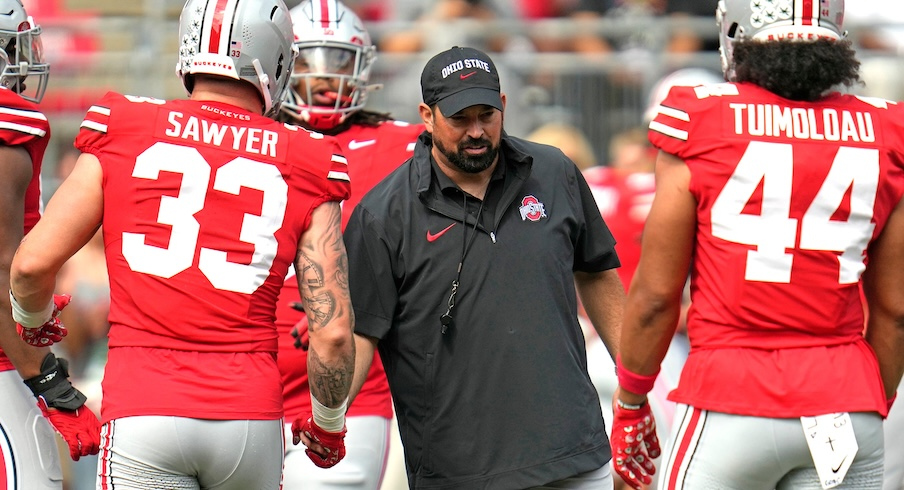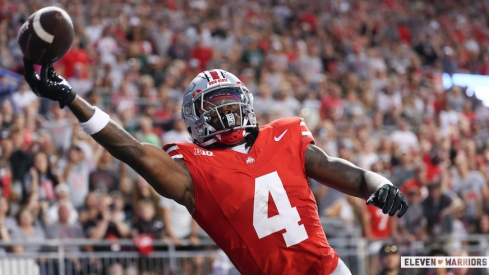Things always seem to come full circle.
When Ryan Day took over as Ohio State's permanent head coach in place of Urban Meyer in 2018, the Buckeyes' outstanding video and creative team made an excellent video where Meyer “passes the sticks” to Day in the college football video game. Fast forward six years, Day is now encouraging his players to play a college football video game as well.
In this day and age, video games have become more realistic than ever. That can be said for all types of games, but when it comes to the new EA Sports College Football 25, it's never been more realistic. A decade in the making, the video game not only uses real players and announcers but also showcases real playbooks.
The latter was a topic of discussion, along with player ratings and the game overall, during the first day of Big Ten Media Days in Indianapolis on Tuesday. The playbooks are so real that Jack Sawyer said Day told his players to play the video game to help learn opponents.
Ohio State DE Jack Sawyer told me Ryan Day told his team to play the new CFB video game to help learn opponents. #BigTen pic.twitter.com/soDyblh6Bm
— Emily Proud (@emily_proud) July 23, 2024
Sawyer and his teammates seem to be listening to Day's advice. At the very least, he's at least enjoying the game already, especially considering he can now play as himself with the Buckeyes.
“I grew up playing that game, was dying for it to come back," Sawyer said. "And it's surreal to be a part of the game its first year back. It's super cool being able to play with the Buckeyes and play with myself. It's a unique experience.”
Denzel Burke said Tuesday he has played the game “every day since it came out.”
Last September, Washington Post's Kent Babb wrote a story about James Rowe III, the older brother of former Rutgers cornerback and current Scarlet Knights' senior analyst David Rowe, discussing how Madden playbooks slowly started to shape and transform real-life playbooks and language in terms of what takes place on the field, before, during and after the snap.
“You just get a ton of reps and a lot of the language,” he says. “If a kid starts playing Madden at 5 years old, 6 years old, really the first playbook everybody sees is from Madden.”
It remains the clearest one in James’s mind. Even after a dozen years as a college and NFL coach, when he imagines cover-two, he pictures the way Madden breaks the defensive side of the field into colorful zones: two safeties patrolling the deep blue, cornerbacks occupying the purple circles near the sideline in case of a quick pass, linebackers dropping into yellow territories to discourage short throws over the middle.
So when the defensive back asked what a “hash dropper” does, James didn’t explain it in football terms — that the defender steps forward after the snap, guarding a zone in the underneath center of the field, traditionally a linebacker’s assignment. He just said the player’s responsibility was a “yellow” zone on Madden.
“He was like, ‘Oh, I got you,’ ” Rowe says. “Nothing else needed to be said.”
It appears as though Day would agree. And now that the playbooks throughout college football can be thought of the same way NFL playbooks are (and were back then) in Madden, anyone, including players, can learn a thing or two about any given team or opponent.
While a video game will never replace real-life film when it comes to preparation, a player can never prepare for an opponent too much, and it seems as though the new video game gives players and coaches another off-field opportunity to study their opponents' schemes and play styles.
Unfortunately for Day, he isn't in the game, as EA Sports elected to not have coaches in the game this year, likely a move to save some money. That said, he loves coaching so much that he coaches his son, RJ, while playing the game, even though he wishes he could be Ohio State's actual head coach in the game itself.
"So I haven't played it, but I coach it. So RJ plays it and I tell him what to run," Day said. "I'm a little disappointed I'm not in it. I'd like to be in it."


